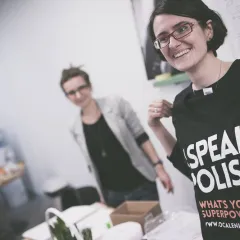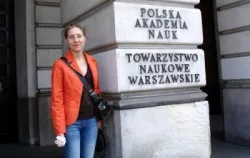What does Warsaw mean to me? How do I see it? What would I like it to be? I saw Warsaw for the first time on 1 May 2004. I was driving from Dworzec Centralny along Marszałkowska Street. I must say that neither the railway station nor Pałac Kultury did impress me as much as empty streets of the city with curtained shop and restaurant windows. The day before there had been the demonstration of the antiglobalists against Poland’s entrance to the EU. Warsaw looked like the decoration of a disaster film. Thanks to it the entire city, and not its separate buildings caught my attention. I have been living in Warsaw since that time, I have written the dissertation on the post-war rebuilding of the Polish capital. Is it possible to love this city? Difficult question. Yes and no. And is it possibile to see this city? Absolutely not. An average tourist visiting Warsaw will not see it. Why? Because this city does not exist. It died in 1944 and now this old historic Warsaw can only be seen in libraries and on scientific conferences. Warsaw has changed greatly. The city does not have a single coherent idea, it is just an architectural mess.
How to see the pre-war Warsaw? Where is it? The old city lives in such streets as Ząbkowska, Brzeska, Stalowa, Inżynierska, Próżna. Will an average tourist find his way there? I doubt. Each time I have visitors, I take them for a walk across the district of Praga to show them the real city. Nobody has been disappointed yet, but everyone fascinated. And every person asks “why?” Why does that real pre-war Warsaw look like that? Praga is for me an obligatory stop of the Museums at Night celebrations. We visit Praga during culture festivals, we go to Koneser and summer cinema. Is Praga well presented in the guides to Warsaw? I suppose so. But do the guides to Warsaw and Warsaw itself present well? In my opinion no.
We already know where to see the pre-war Warsaw. And where do we find the signs of the wartime city? Are they shown well in the urban space? We all know the place of the Berlin Wall, but are we able to point out where the Warsaw ghetto was (there is even the notice on the pavement), where the remains of the wall are? They are difficult to find in the urban space.
It is not easy to find Warsaw in Warsaw. What we see coming to the Polish capital are: Pałac Kultury i Nauki, Old Town, Royal Palace, Łazienki, Wilanów and recently the Warsaw Rising Museum. And is that enough? What about the Citadel, the remains of the Warsaw ghetto, the Vistula river or excellent villas of Saska Kępa? I think Warsaw may be attractive but one has to know how to show it.
The Warsaw Citadel is one of the few fortresses of that kind in Europe, but nobody knows about it. I even encountered surprise from people who have been living in Warsaw for some years and did not know there was the citadel there.
The Citadel may be a source of money and it is worth making a tourist attraction, transfer the army command headquarters from there and turn it into a tourist entertainment centre: hotels, bars, restaurants, museums, galleries. Besides, there are a lot of forts round the Citadel, which can also be adapted properly. It is a great place to organize the open-air events and promote the history of the city, as the Citadel is quite an important spot on a historical map of Warsaw. Why not lengthen the tourist route northward? The Citadel – New Town – Old Town – Krakowskie Przedmieście...?
Each European capital is situated on the river bank, but only in Warsaw the river is a line on the map, something that divides the city. For many years there have not been an idea for the development of Vistula wharves, which is worth investing.
Wharf development (only the left bank and the right bank would be left as it is, just as e.g. in Kiev) including a decent bicycle lane, a promenade, bars, eateries, attractions for children would make the Varsovians notice at last the presence of the river as an active participant of the life of the Polish capital. And the tourists? They would have the opportunity of going for an evening or even night walk. When it comes to the bicycle lanes, Krakowskie Przedmieście has been recently renovated: the pavements were broadened but bicycle lanes were not build. In a tourist part of Warsaw there is no other way of riding a bike like along the road. It is sad because the renovation of Krakowskie Przedmieście was done with the idea of improving the image of the city and attracting tourists. Chopin’s benches and stone tourist guides were made but the bicycle lanes were forgotten.
I have written at the beginning that Warsaw is an architectural mess. From the one side it is wrong as each city must have a coherent idea of land development. Making comparison between Warsaw and Berlin, which was also destroyed, one can see that what was built during the last years, naturally fitted into the city landscape. But on the other side such architectural mess is extremely interesting: we have Lew Rudniew’s and Sir Norman Foster’s masterpieces standing next to each another. Anyway, speaking about the latter, do you know where the worldwide known architect’s masterpiece is? It is the Metropolitan building at Piłsudski Square. People around the world are delighted with Fosters’ buildings; it is an honour for Warsaw that such a notable architect has designed one of its office blocks. Isn’t it a great reason to promote the city? Unfortunately it was not made use of.
Pałac Saski was also not made use of, and especially its foundations, which were discovered a few years ago during the renovation. I remember how popular those labyrinths of foundations were among the Varsovians and tourists – everyone tried to peep through a crack in a fence to see them and they were finally opened to the tourists. In Kazan, the capital of Tatarstan, during the renovation of the old part of the city the former foundations were discovered and preserved. Today, when we go along the street, we can see them under the glass, as the pavement is in some places made of thick glass in order to make this attraction possible to be viewed. In Warsaw the foundations were buried again - another reason to promote the city, which was not considered.
Neither Piskorski, Kaczyński nor the present President of Warsaw did not have the idea for the city. Paweł Piskorski started a very important debate for Warsaw, concerning the inclusion of Pałac Kultury into the list of vintage buildings. For me, as the Muscovite, Pałac Kultury is something important and understandable, it is my, our part of the city. I realize how other people see this building. It is a very characteristic spot, a symbolic and historic monument. Pałac Kultury is an authentic witness of the history of the post-war Warsaw – the communist Warsaw, just like Brzeska St. is an authentic part of the old Warsaw. It is something that amazes western tourists and gives tourists from the East some feeling of “home”. It fits perfectly into the city life. And what about the neighbouring district Marszałkowska Dzielnica Mieszkaniowa (MDM)? MDM is a kind of “an open-air museum” of the socialist realistic architecture, which is also worth promoting but not made use of so far.
It is interesting that Warsaw consists of different „pieces” and walking along some routes you encounter the pieces of its history, you are the tourist and simultaneously the explorer of the city. In the western part of the centre, behind skyscrapers one will find old, one-storey buildings and walking across Plac Defilad we will see the boards informing about old buildings. It is a pearl of Warsaw, but still the unknown, not promoted pearl.
A crucial step towards the promotion of the city was opening of the escalator with the exposition of old low reliefs, mechanisms and magazines, showing the history of that object. Such places make Warsaw attractive for tourists.
The fortresses of Modlin and Czersk are situated near Warsaw but they lack a good, comfortable, fast and easy access for tourists. Not far from Prague there is the castle of Karlshtein where one can get by train and which is a famous and accessible tourist destination. Would a similar situation be harmful to Warsaw?
I look at Warsaw as the inhabitant of this city. It is my city, I love it, I know it and I still try to get to know it better. I can proudly say that before I moved here neither of my friends had ever been to Poland, all the more to Warsaw. Now it is not the unknown subject. The moment they come here, I try not to allow them to walk alone because they will not really see and feel Warsaw. I show them something different from the present tourist routes and it fascinates them. They are usually surprised that this absolutely unknown city is so interesting. Anyway, two years ago I have started to write a guide to Warsaw in Russian to promote that city in Russia but I still do not have time to complete it as Warsaw is a very broad subject for me.
All the immigrants I know like Warsaw – some of them more, some of them less, but to see Warsaw it is necessary to live there. It is impossible to get to know it during one or two days coming as a tourist, because of all those things I have written about. I am sad that Warsaw loses so much in comparison to other European capitals as it really has a great potential and many interesting things to offer.
Warsaw is one of the candidates to the title of the “European Capital of Culture 2016”. Will it be near to win? Yes, if the Vistula starts to exist on the city map as a river. Yes, if the Citadel is included into the cultural-museum life of Warsaw. Yes, if the tourist tram from Starówka gets to Praga. Yes, if the city councilors have a coherent idea of how to promote the Polish capital.
Text by Maria Strelbicka
Translated by Anna Piątek







































